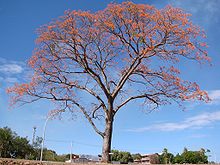- Erythrina mulungu
-
Mulungu 
Scientific classification Kingdom: Plantae (unranked): Angiosperms (unranked): Eudicots (unranked): Rosids Order: Fabales Family: Fabaceae Genus: Erythrina Species: E. mulungu Binomial name Erythrina mulungu
Mart. ex Benth.[verification needed]Synonyms Corallodendrum mulungu Kuntze
Erythrina flammea Herzog
Erythrina verna Vell.Erythrina mulungu (Mulungu) is a Brazilian ornamental tree and medicinal plant native to the cerrado and caatinga ecoregions in Brazil , South America.
Studies show that the herb is a sedative, and has anxiolytic and anticonvulsant properties,[1][2][3][4] with the active components thought to be the tetrahydroisoquinoline alkaloids erythravine and (+)-11α-hydroxy-erythravine.[5]
Contents
Medicinal uses
Mulungu is not very widely known or used in North America; mostly appearing as an ingredient in only a few herbal formulas for anxiety or depression.[6]
Typical preparation is to make an infusion of the bark or root and drink the infusion as a calmative. Other methods include preparing a tincture, which is then consumed in small amounts.
Some sites include warnings about mulungu's potency as a sedative and also compare it to kava,[citation needed] a natural plant medicine already in common, widespread use as an herbal sedative.
See also
References
- ^ Onusic GM, Nogueira RL, Pereira AM, Viana MB. (2002). "Effect of acute treatment with a water-alcohol extract of Erythrina mulungu on anxiety-related responses in rats.". Braz J Med Biol Res. 35 (4): 473–7. doi:10.1590/S0100-879X2002000400011. PMID 11960198.
- ^ Vasconcelos SM, Macedo DS, de Melo CT, Paiva Monteiro A, Rodrigues AC, Silveira ER, Cunha GM, Sousa FC, Viana GS. (2004). "Central activity of hydroalcoholic extracts from Erythrina velutina and Erythrina mulungu in mice.". J Pharm Pharmacol. 56 (3): 389–93. doi:10.1211/0022357022746. PMID 15025865.
- ^ Ribeiro MD, Onusic GM, Poltronieri SC, Viana MB. (2006). "Effect of Erythrina velutina and Erythrina mulungu in rats submitted to animal models of anxiety and depression.". Braz J Med Biol Res. 39 (2): 263–70. doi:10.1590/S0100-879X2006000200013. PMID 16470314.
- ^ Vasconcelos SM, Lima NM, Sales GT, Cunha GM, Aguiar LM, Silveira ER, Rodrigues AC, Macedo DS, Fonteles MM, Sousa FC, Viana GS. (2006). "Anticonvulsant activity of hydroalcoholic extracts from Erythrina velutina and Erythrina mulungu". J Ethnopharmacol. ? (?): 271–4. doi:10.1016/j.jep.2006.09.023. PMID 17070003.
- ^ Flausino Jr, OA; Pereira, AM; Da Silva Bolzani, V; Nunes-De-Souza, RL (2007). "Effects of erythrinian alkaloids isolated from Erythrina mulungu (Papilionaceae) in mice submitted to animal models of anxiety". Biological & pharmaceutical bulletin 30 (2): 375–8. doi:10.1248/bpb.30.375. PMID 17268084.
- ^ http://www.rain-tree.com/mulungu.htm
External links
- International Legume Database & Information Service: Erythrina verna
- (Portuguese) University of São Paulo: Erythrina mulungu photos
Categories:- Erythrina
- Trees of Brazil
- Medicinal plants
- Faboideae stubs
Wikimedia Foundation. 2010.

